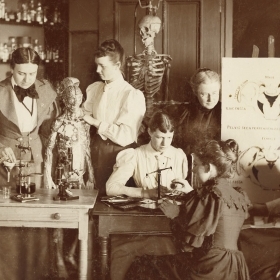Linda Esslinger Heusser ’54
Linda Esslinger Heusser ’54, an adjunct research scientist at Columbia University’s Lamont-Doherty Earth Observatory, wants women to continue seeing science as a career option

Linda Esslinger Heusser ’54, an adjunct research scientist at Columbia University’s Lamont-Doherty Earth Observatory, wants women to continue seeing science as a career option. While some of the sexism she faced—like being sent out to fetch meals while doing fieldwork in Chile because she was the only woman on the team—may be less prevalent now, she knows other hurdles remain. Like child care. She relied on day care subsidized by her in-laws when she began grad school. But these days, Columbia isn’t likely to decline admission to a qualified student because she is female, as it did when she was applying to graduate school. That’s why Linda earned her doctorate at New York University instead.
A psychology major at Wellesley with fond memories of art history courses, Linda became interested in Earth science when she read her husband’s historical geology textbook. “It really was like a deus ex machina,” she says. “I just knew that I wanted to be a paleontologist.”
Linda has spent her career working on understanding the Earth’s historical climate cycles by identifying the types of pollen found in sediment cores pulled up from deep beneath the sea—and she’s still at it at age 90.
Because she had three small children when she began graduate school, joining a research cruise for months at a time wasn’t an option. But those scientists would need a colleague to do pollen studies. Some men felt hesitant to share “their” cores with her, but once she was in the mix, she made significant contributions. In the late 1970s, she was looking at samples from a North Pacific core. Microscope slides she made from a particular point revealed alder pollen. She knew that indicated a change had occurred in the climate on land where those pollen grains had fallen to the ground. They then washed into the ocean and settled to the bottom.
Nick Shackleton, a founder of paleoclimatology—the study of Earth’s past climates (and great-nephew of the Antarctic explorer Ernest Shackleton) ran a different set of studies on the same core. Back then, figures that displayed a scientist’s data were hand-drawn by a draftsperson and shared at in-person meetings. It was a big deal when he and Linda pinned up their large diagrams side-by-side. Their combined results immediately revealed a new discovery.
“That was it,” she says. “The first time that there was direct correlation between what happened on land and the marine record.” Their paper was published in Science in 1979.
When Linda was invited to speak about their work at a national meeting, she wanted a visual to help people quickly grasp the idea of how pollen becomes part of the marine record. She asked a scientific illustrator to draw a cartoon. The artist first drew a dinosaur, Linda says, “and I said, ‘No, no, we’re dealing with the Pleistocene.’” Dinosaurs roamed the Earth far earlier. Linda still has the drawing of “a little mammoth who’s looking at some pollen grains.” (See drawing below.)
The Zoom box that frames Linda’s cheerful face during a call from her office at Columbia includes an enlarged photo of a pine pollen grain. She limits her lab time to half days now, as walking and standing have become more difficult. Recently, she received samples from a core that will keep her busy for months. As long as she can still drive and can still identify pollen, she plans to keep helping other scientists, many of them women, unlock the climate secrets stored in mud under the sea. Retirement is unappealing.
“What would I do?” she asks.
[supporting-images]


